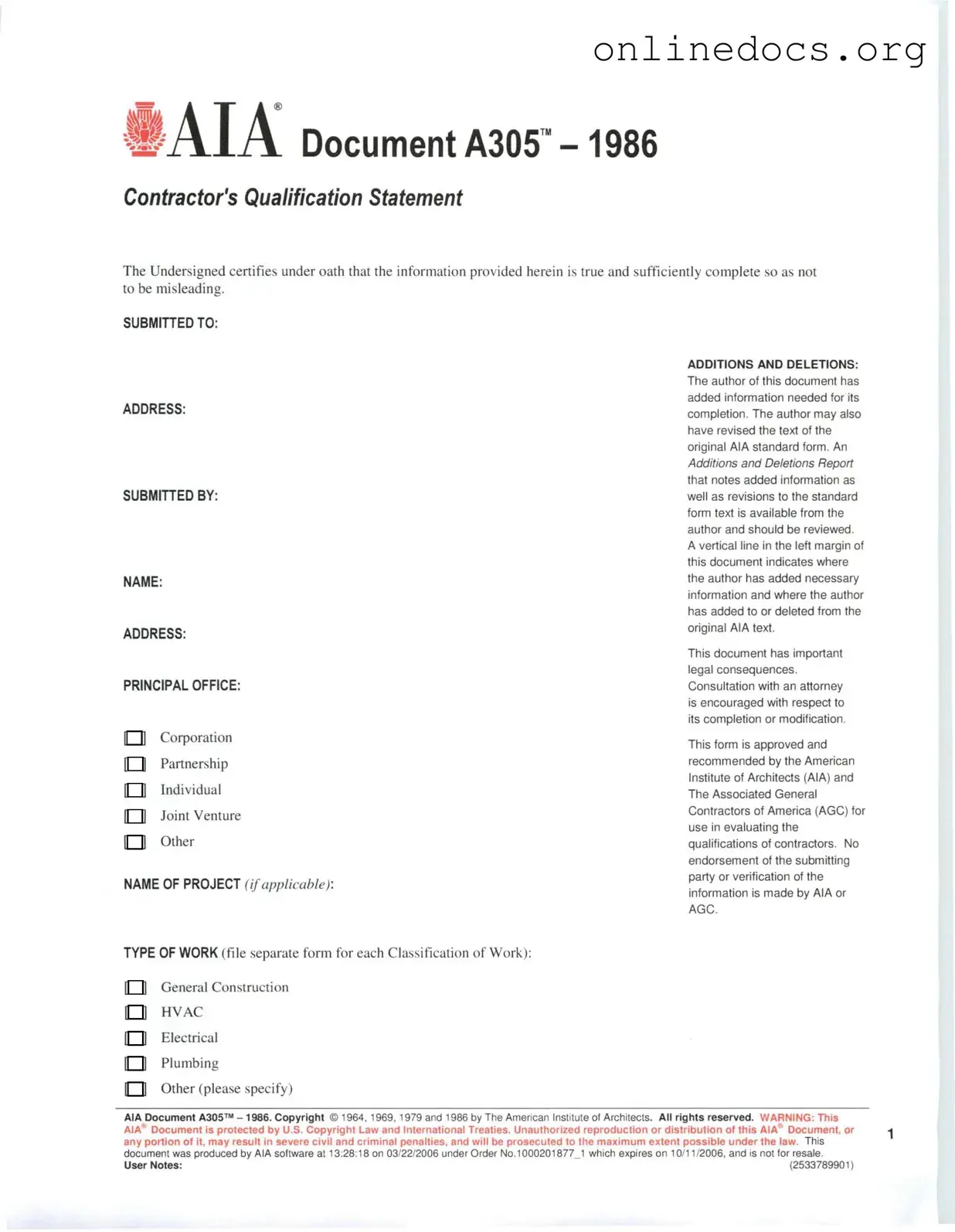The AIA A305 form, known as the Contractor's Qualification Statement, is a vital document in the construction industry. It gathers essential information about a contractor's qualifications, experience, and financial stability. Similar to the AIA A305, the AIA A201 form outlines the general conditions of the contract for construction. This document establishes the responsibilities of both the owner and the contractor, ensuring clarity in the contractual relationship. By setting forth standard procedures and expectations, it helps mitigate disputes and promotes a smoother project execution.
Another document that shares similarities with the AIA A305 is the AIA A310, the Bid Bond form. This form is used to guarantee that a contractor will enter into a contract if selected for a project. Like the A305, the A310 assesses the contractor's reliability and financial capability. It serves as a protective measure for the project owner, ensuring that the bidding contractor has the necessary backing to fulfill the contract obligations.
The AIA A401 form, which is the Standard Form of Agreement Between Contractor and Subcontractor, is also comparable to the A305. This document outlines the relationship between the contractor and subcontractors, detailing the terms of their agreement. Just as the A305 evaluates a contractor's qualifications, the A401 ensures that subcontractors meet specific criteria, thereby maintaining the quality and integrity of the overall project.
In addition, the AIA G702 form, Application and Certificate for Payment, shares a connection with the A305. The G702 form is used to request payment for work completed, ensuring that contractors provide adequate documentation of their progress. Both forms emphasize the importance of transparency and accountability in the construction process, fostering trust between all parties involved.
The AIA G703, Continuation Sheet for G702, complements the G702 by providing a detailed breakdown of the work completed. This document is similar to the A305 in that it requires thorough documentation to support payment requests. By ensuring that all work is properly accounted for, it helps prevent misunderstandings and disputes regarding payment.
The AIA C620 form, which is the Standard Form of Agreement Between Owner and Architect, also bears similarities to the A305. This document establishes the relationship between the owner and the architect, outlining the scope of work and responsibilities. Like the A305, it emphasizes the importance of clear communication and mutual understanding, which are crucial for the success of any construction project.
The AIA A305 form, also known as the Contractor's Qualification Statement, is similar to the AIA A201 document. The A201 outlines general conditions for a construction contract and sets expectations for performance, compliance, and dispute resolution. While the A305 focuses on the qualifications and capabilities of the contractor, the A201 serves as a broader framework governing the overall construction project, including obligations and rights of all parties involved. For those looking for legal documents related to property transfers, resources such as legalformspdf.com can be invaluable.
The AIA A232 form, which pertains to the General Conditions of the Contract for Construction, is another document that aligns with the A305. This form defines the roles and responsibilities of all parties involved in the project. By providing a framework for collaboration and communication, it helps ensure that everyone is on the same page, reducing the likelihood of conflicts and delays.
Finally, the AIA G701, Change Order form, is similar to the A305 in that it addresses modifications to the original contract. Change orders are common in construction projects, and this form ensures that all changes are documented and agreed upon by all parties. By maintaining a clear record of changes, it helps protect the interests of both the contractor and the owner, ensuring that the project remains on track.
